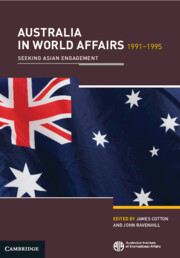Book contents
- Frontmatter
- Contents
- Tables
- Abbreviations
- Contributors
- Preface
- 1 Australia’s ‘Engagement with Asia’
- 2 An Overview
- 3 The Rhetoric of Asia
- 4 Australia and Asia: A View From Europe
- 5 Australia’s Defence Policies in the Post–Cold War Era
- 6 Australia, Disarmament and Arms Control
- 7 Australia and the World Economy 1991–95: Closer Economic Integration with Asia?
- 8 Australia and the International Environment
- 9 Australia and Japan
- 10 Australia and Southeast Asia
- 11 Australia and China, 1991–95: Asymmetry and Congruence in the Post–Cold War Era
- 12 Australia and the Four Asian Dragons: Beyond the Economic Agenda?
- 13 Reassessed: Australia’s Relationship with the United States
- 14 Australia and the European Union
- 15 Australian Relations with the Former Communist States of Europe and the Soviet Union
- 16 Australia and New Zealand: Unequal Partners on the Periphery
- 17 Australia and the South Pacific: The Rationalist Ascendancy
- Notes
- Index
7 - Australia and the World Economy 1991–95: Closer Economic Integration with Asia?
Published online by Cambridge University Press: 04 May 2024
- Frontmatter
- Contents
- Tables
- Abbreviations
- Contributors
- Preface
- 1 Australia’s ‘Engagement with Asia’
- 2 An Overview
- 3 The Rhetoric of Asia
- 4 Australia and Asia: A View From Europe
- 5 Australia’s Defence Policies in the Post–Cold War Era
- 6 Australia, Disarmament and Arms Control
- 7 Australia and the World Economy 1991–95: Closer Economic Integration with Asia?
- 8 Australia and the International Environment
- 9 Australia and Japan
- 10 Australia and Southeast Asia
- 11 Australia and China, 1991–95: Asymmetry and Congruence in the Post–Cold War Era
- 12 Australia and the Four Asian Dragons: Beyond the Economic Agenda?
- 13 Reassessed: Australia’s Relationship with the United States
- 14 Australia and the European Union
- 15 Australian Relations with the Former Communist States of Europe and the Soviet Union
- 16 Australia and New Zealand: Unequal Partners on the Periphery
- 17 Australia and the South Pacific: The Rationalist Ascendancy
- Notes
- Index
Summary
At the end of 1995, the global economic environment appeared far more favourable to Australia than at the beginning of the decade. The worst fears of the early 1990s had failed to materialise. The Uruguay Round of negotiations in the General Agreement on Tariffs and Trade (GATT) had been concluded and GATT’s successor, the World Trade Organisation (WTO), established. With a successful outcome to the GATT negotiations, the threat of the global-trading system fragmenting into rival regional trading blocs largely receded. The establishment of the Single Internal Market in 1992 and the conversion of the European Community into the European Union with the Maastricht Treaty of the following year came and went with no evidence of adverse impact on its trading partners: ’Fortress Europe’ did not eventuate. Even agriculture, very much the orphan child of the world community’s postwar moves towards liberalised trade, was brought under WTO auspices; the requirement that barriers protecting agriculture be converted into tariffs by the end of the century promises to bring greater transparency in agricultural trade and, with it, the possibility of more effective pressure for liberalisation.
Keywords
- Type
- Chapter
- Information
- Australia in World Affairs 1991–1995Seeking Asian Engagement, pp. 68 - 81Publisher: Cambridge University PressFirst published in: 2024



